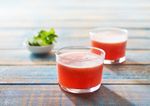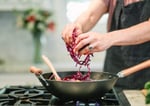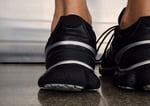Alcohol-free alcohol – how healthy is it really?
by Gael Myers, Accredited Practising Dietitian
- December 24, 2019
- Leave a comment
- WA
- Marketing
- Alcohol
- Mythbusting
- Sugary drinks
- Shopping
- Weight Management
- Industry
- Cancer
- Wellness
- Research

With the popularity of non-alcoholic alcohol drinks on the rise these drinks are moving from the fringe to being a viable option when you are staying away from booze. One brand has even positioned itself not just as an alcohol alternative, but as a ‘healthy’ alternative to soft drink. The problem is – there’s very little information out there about how healthy these drinks actually are.
To find out more we scoured 26 bottle shops and supermarkets in the Perth metro area looking for non-alcoholic versions of your favourite beer, wine, cider and spirits. To assess the ‘healthiness’ of these drinks, we compared the number of kilojoules in a bottle or glass against their alcoholic versions. An alcoholic beer has around 510kJ per 330mL bottle while a 150mL glass of regular wine contains around 460kJ. A 300mL bottle of cola contains around 540kJ.
Here’s what we found
Non-alcoholic beer
There were 15 different non-alcoholic beers available in the stores included in our sample. These had an average of 313kJ per bottle, which is more than half the kilojoules of a full-strength beer (and around half the kilojoules of a soft drink). The lowest kilojoule non-alcoholic beer had just 92kJ a bottle while the highest kilojoule option contained 389kJ – quite a range!
Non-alcoholic wine
We were surprised to see the large range of non-alcoholic wines available – 29 in total. The non-alcoholic wines contained an average of 183kJ per glass, which is less than half the kilojoules in regular wine.
Other alcohol alternatives
Only one non-alcoholic cider and one brand of non-alcoholic spirits were found in our search.
The non-alcoholic cider contained more kilojoules than a soft drink – so not a great choice!
The non-alcoholic spirits were kilojoule free (basically water with herbs and spices) but it’s important to consider what you would serve them with. With only slightly less kilojoules than a cola, tonic water packs a surprisingly sugary punch so watch out if this is your mixer of choice!
Lowest kilojoule options
|
|
|
Kilojoules per 100mL |
Kilojoules per serve |
|
Non-alcoholic beer |
Brew dog alcohol-free hoppy ale (355mL) |
26 |
92 |
|
Holsten alcohol-free beer (330mL) |
50 |
165 |
|
|
Weihenstephaner alcohol-free original Helles (500mL) |
58 |
290 |
|
|
Non-alcoholic wine
|
Miranda non-alcoholic Sauvignon Blanc |
48 |
72 |
|
Miranda non-alcoholic Shiraz |
66 |
99 |
|
|
Vintense non-alcoholic Merlot |
72 |
108 |
|
|
Edenvale non-alcoholic Rosé |
75 |
113 |
|
|
Vintense non-alcoholic chardonnary |
76 |
114 |
|
|
Other |
Seedlip non-alcoholic spirit |
0 |
0 |
Highest kilojoule options
|
|
|
Kilojoules per 100mL |
Kilojoules per serve |
|---|---|---|---|
|
Non-alcoholic beer |
Carlton Zero (330mL) |
118 |
389 |
|
Krombacher non-alcoholic pils (330mL) |
111 |
366 |
|
|
Clausthaler low alcohol lager (330mL) |
108 |
356 |
|
|
Non-alcoholic wine
|
Maggie Beer non-alcoholic sparkling chardonnay |
265 |
398 |
|
Fronti non-alcoholic sparkling white |
245 |
368 |
|
|
Lindeman’s Maiden Press lightly sparkling Shiraz |
227 |
341 |
|
|
Fronti non-alcoholic sparkling red |
225 |
338 |
|
|
Other |
The Hills cider company virgin apple cider (330mL) |
224 |
739 |
So what’s the benefit in drinking less booze?
There’s no getting around it – alcohol is a cause of eight types of cancer.
The more you drink and the more often you drink the greater your risk.
Switching to non-alcoholic alcohol drinks is a great way to reduce your intake of alcohol and therefore your risk of developing these cancers.
BUT… it’s important to realise that carrying too much weight can also put you at risk of cancer. It’s easy to overconsume drinks as they don’t fill you up in the same way that food does, meaning that we can easily drink a lot of kilojoules without realising it.
When choosing a non-alcoholic beer or wine make sure you take a look at the nutrition label to see how many kilojoules are hiding there. We’d suggest choosing non-alcoholic beers with less than 70kJ per 100mL, and non-alcoholic wines with less than 90kJ pe



